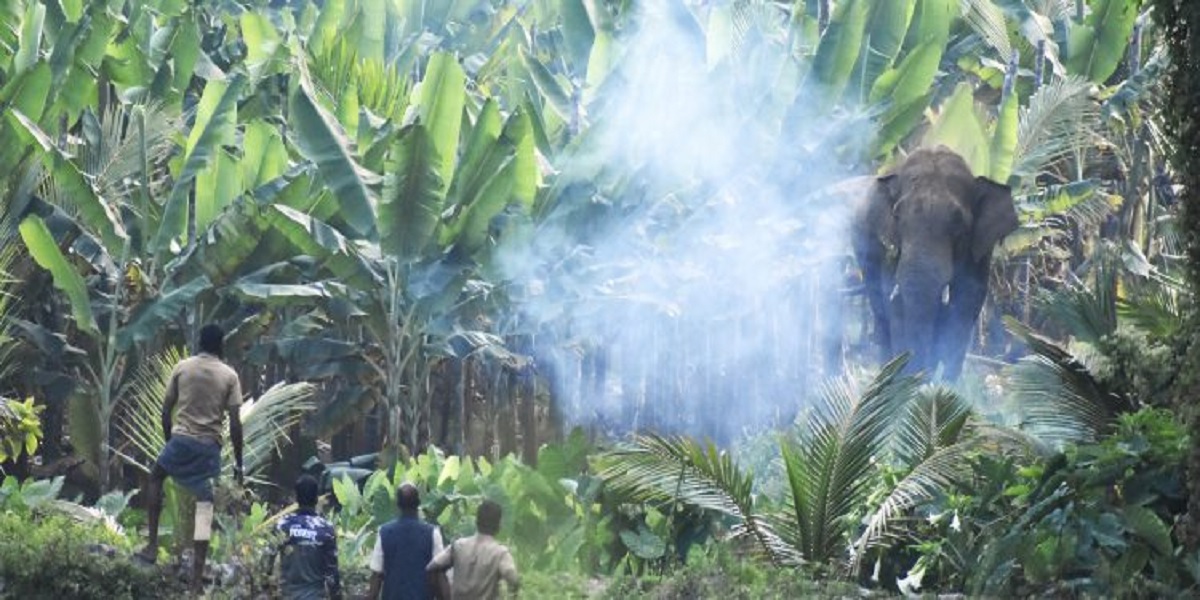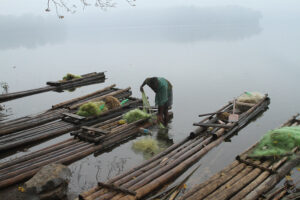Kerala recorded 8,873 incidents of human-wildlife conflicts, resulting in 98 human casualties and 871 injuries in 2022-23. Additionally, 65 cattle deaths were also reported.
Published Oct 16, 2024 | 7:00 AM ⚊ Updated Oct 16, 2024 | 11:16 AM

According to figures presented in the Assembly, Kerala witnessed 915 human casualties in man-animal conflicts over the past nine years.
The statistics on man-wildlife conflict in Kerala painted a grim picture with 915 people losing their lives in the past nine years.
Most number of fatalities were reported in 2018-19 with man-animal conflicts killing 146 people, according to official statistics presented in the state Assembly.
This year alone, 19 people fell victim to wild animals and the government has identified 281 highly-prone panchayats.
The government informed the Assembly that it had provided a compensation of ₹27 crore to the families of those killed in man-animal conflicts in nine years. Another ₹24 crore was distributed among 7,917 people, injured in wildlife attacks.
Kerala has been witnessing a surge in man-animal conflicts, mostly caused by elephants, tigers, and wild boars. To address the issue, the state has invested ₹33.19 crores in various preventive measures, including the construction of solar fences, trenches, defensive walls, hanging fences, crash-guard fences, stone walls, rail walls, and compound walls.

Kerala has been witnessing a spurt in human-wildlife conflicts.
Incidentally, in a first in India, Kerala declared the man-animal conflict a state-specific disaster on 6 March 2024.
The state forest department recorded 39,484 incidents of man-animal conflict between financial years 2019-20 and 2023-24.
According to the Economic Review 2022-23, Kerala reported 8,873 incidents of human-wildlife conflicts, resulting in 98 human casualties and 871 injuries. Additionally, 65 cattle deaths were also reported.
While these figures have garnered significant media attention, they raise questions about the actual situation on the ground.
A close aide of state Forest Minister AK Saseendran told South First that the forest department was actively developing a new policy to address the escalating man-animal conflict.
“We are currently conducting a survey, and have already identified eight high-risk hotspots. Our focus is now on implementing more effective preventive measures in these areas,” he said.
“The policy’s first phase will be presented in a month. It will comprehensively cover all aspects of the conflict, including prevention strategies, awareness campaigns, and even insurance coverage. We are in talks with an insurance company to finalise details,” he added.
The source also emphasised that discussions with the Disaster Management Authority were on, as the man-animal conflict has now been classified as a state-specific disaster.
“Coordinating with multiple departments, including Revenue, Local Governance, Disaster Management, and Health, is crucial. This policy will be groundbreaking and the first of its kind in India,” he added.
Speaking exclusively to South First, Assistant Conservator of the Biodiversity Cell Muhammad Anvar said various measures, such as solar fences, hanging solar fences, and elephant scent fences, have been put up across different terrains to mitigate human-wildlife conflict.
While effective in Bandipur, Karnataka, scent fences were found unsuitable for Kerala’s landscape.
However, solar and hanging solar fences have proven successful in deterring elephants, wild boars, and gaurs, but could not prevent tigers, leopards, and monkeys.
Kerala has identified 15 major human-wildlife conflict hotspots, including Aralam in Kannur, Wayanad, Nilambur in Malappuram, Mannarkkad in Palakkad, Vazhachal in Thrissur, and Munnar in Idukki.
The conflict in Munnar has been seasonal, peaking during elephant migration periods, particularly in the summer when elephant herds move across Karnataka, Tamil Nadu, and Kerala in search of water and fodder.
Wayanad has been witnessing significant conflicts, as elephants tend to settle there when the eastern parts of the Western Ghats dry up. In contrast, areas like Mannarkkad face continuous conflicts.
In the past six months, 2,516 elephant interactions were reported, with forest department interventions preventing harm in 1,750 cases. Despite these efforts, 600 cases resulted in crop and property damage.
Anvar said wildlife experts in Kerala were facing significant challenges due to public and media interference during emergencies. Crowds often gather at conflict sites, hindering rescue operations and creating a chaotic environment.

Arikomban roams a tea estate in Munnar before capturing. (Supplied)
In several incidents, forest officials and wildlife experts struggled to reach the scene due to the overwhelming number of people. For instance, in a case where a leopard fell into a well, the crowd gathered, obstructing the rescue effort.
In some areas, the police controlled the crowds and ensured the safety of both humans and animals. This was notably seen during the translocation of Arikkomban — a ration shop-raiding tusker with a taste for rice. Section 144 of the CrPC had to be invoked to prevent disruptions.
However, in most cases, forest department staff work under immense pressure, exacerbated by sensationalist media coverage that often overshadows the positive aspects of wildlife management.
Mismanagement by the public has also contributed to incidents such as a fox biting over 20 people in Kannur after they gathered on the road to watch it on 20 August 2024.
The forest department has made notable progress in reducing human-wildlife conflict incidents by establishing forest emergency operating centers that collect and verify daily data. Reported cases have significantly decreased from 6,500-8,500 to around 650, Anvar said.

A tribesman engaged in fishing at Parambikulam Tiger Reserve. Parambikulam Tiger Reserve is the home of four different tribes, the Kadar, Malasar, Muduvar and Mala Malasar settled in six colonies inside the reserve. (Kerala Tourism website)
The reduction in snakebite deaths, which previously accounted for 80 percent of wildlife-related fatalities, is another success story. Public education, along with the SARPA app and training programmes for snake catchers, has significantly contributed to the decline, with only 14 snakebite deaths reported this year.
The Economic Review had put the number of human casualties following snakebites at 48 in 2022-23.
Indigenous communities, particularly in the Parambikulam Tiger Reserve spread over Palakkad and Thrissur districts, have showcased the art of coexistence with wildlife.
Tribal workers and guides navigate roads frequented by dangerous animals such as elephants, wild boars, and bears without incident, demonstrating their deep understanding of the forest ecosystem.
Despite the forest department’s significant efforts, such as water and moisture conservation, wildlife protection, and habitat improvement, their contributions often go unacknowledged.
The department continues to play a crucial role in ensuring the health of Kerala’s 44 major rivers, which originate from the Western Ghats, highlighting the importance of proper forest management for sustaining life in the region.
In a recent incident at Kakkatthode, Elappully, Palakkad, five wild boars that had fallen into a well were shot dead on public demand.
The community, grappling with significant crop losses due to increasing wild boar activity, pressured authorities to take swift action.
With approval from the panchayat and the forest department, one person entered the well to tie the boars with ropes before they were killed and removed.
Speaking to South First, Kakkaathodu panchayat member Saravanan Kumar highlighted the challenges faced by the farmers in the area.
“In our locality, most people depend on agriculture, and the damage caused by wild boars has been immense. We have licensed shooters, but sometimes, despite patrolling, no wild boars are located,” he said.
“When we approach the shooters, they ask us to find the boars first. The forest department has said local bodies can take action, but many people are worn out from protesting and fear the legal complications,” he explained.
Advocate Sreejithkumar MP, a social activist from Kozhikode and a resident of Masinagudi in Tamil Nadu, shared his unique experience with wildlife in a conversation with South First.
“A wild elephant regularly visits my property in Masinagudi but has never caused any damage. However, the same elephant destroyed my neighbour’s property. The difference lies in their reaction—they make noise and throw stones at the elephant, which provokes it to retaliate,” he said.
The local tribal communities, on the other hand, don’t face such conflicts because they understand the need to respect wildlife and live in harmony with it.
Though the damage caused to people has been discussed, the harm humans inflict on animals is rarely talked about.
Most people enter the forest for entertainment and view animals as threats, which leads to fear and defensive reactions from the wildlife. Many elephants and deer suffer injuries due to human interference, and even the plastic waste left behind has been a severe threat to their lives.
“People should become more aware of how to coexist with wildlife, especially in a state like Kerala. This is the only real solution,” Sreejith said.
“We could also learn from practices in other countries, such as controlled hunting of overpopulated animals. It’s about finding a balance where both humans and animals can live peacefully together,” he added.
(Edited by Majnu Babu).
